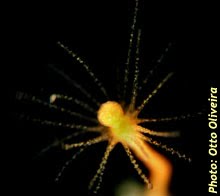Five species were identified from rocks and dock pilings at three locations on Governador Island and three on Paquetá during a six-month study: Dipurena reesi Vannucci, 1956 (Corynidae), Ventromma halecioides (Alder, 1859) (Kirchenpaueriidae), and Obelia dichotoma Linnaeus, 1758, Clytia gracilis (M. Sars, 1850), and Clytia hemisphaerica (Linnaeus, 1767) (Campanulariidae). This small number contrasts with that recorded in the intertidal zone by investigators in other parts of Brazil and elsewhere worldwide.
The presence or absence of hydroids in marine environments is due to the influence of a complex of abiotic and biotic variables including salinity, substrate type, hydrodynamism, and pollution. According to CALDER (1976, 1983, 1991a, 1991b) and CALDER and MAŸAL (1997) reductions in salinity along estuarine haloclines are accompanied by decreases in numbers of species. Moreover, species richness is low in areas subjected to wide salinity oscillations. In Guanabara Bay, salinity usually varies from a maximum of 35.02 to a minimum of 8.7 psu (VALENTIN et al. 1999a). In terms of substrate, some species actively select the bottom type upon which they settle (NISHIHIRA 1969), while others are substrate generalists. In this study, the most common species, Obelia dichotoma, appeared to be a substrate generalist, whereas species of Clytia were collected predominantly on algae or polychaete tubes. Hydrodynamism varied at the different localities: in Paquetá, waters at station P1 become choppy in the afternoon, when southerly winds gain strength, whereas at P2 and P3 waters remain calm. On Governador Island, stations G1 and G2 are gently sloping, making these beaches relatively low energy (tranquil); by contrast, G3 is influenced by currents of the Boqueirão Channel that is more than 10m deep at some points.
Finally, hydroid populations tends to be richer in clean waters but much less so in localities with a high degree of pollution. Guanabara Bay adjoins the second-largest industrial complex and the second-largest demographic center of the country. The presence of (1) the Rio- Niterói ferry docks, (2) the Rio de Janeiro port, (3) approximately 16 terminals for oil derivatives, (4) two oil refineries, (5) nearly 6,000 factories, (6) domestic trash discarded in huge dumps around its shores, (7) discharge of inadequately treated domestic effluents, and (8) the large amounts of organochlorate and organophosphate agrochemicals leaching into the rivers have, unhappily, made Guanabara Bay one of the most polluted ecosystems in the world (MAYR et al. 1989, LAVRADO et al. 1991, VALENTIN et al. 1999a, 1999b, RIBEIRO and KJERFVE 2002). Thus, the main factor limiting species richness of hydroids in the study area is believed to be the degree of disturbance to which the ecosystem has been exposed in recent years, principally in the northwest sector where this research was undertaken.
References:
- BOERO, F. 1984. The ecology of marine hydroids and effects of environmental factors: a review. Marine Ecology 5(2):93-118. doi: 10.1111/j.1439-0485.1984.tb00310.x
- CALDER, D.R. 1976. The zonation of hydroids along salinity gradients in South Carolina estuaries, pp. 165-174. In: G.O. Mackie (ed.) Coelenterate Ecology and Behavior. Plenum Press, New York.
- CALDER, D.R. 1983. Hydroida from estuaries of South Carolina, USA: families Sertulariidae and Plumulariidae. Proceedings of the Biological Society of Washington 96(1):7-28.
- CALDER, D.R. 1991a. Abundance and distribution of hydroids in a mangrove ecosystem at Twin Cays, Belize, Central America. Hydrobiologia 216-217:221-228. doi: 10.1007/BF00026466
- CALDER, D.R. 1991b. Associations between hydroid species assemblages and substrate types in the mangal at Twin Cays, Belize. Canadian Journal of Zoology 69(8):2067-2074.
- CALDER, D.R. and MAYAL, E.M. 1997. Dry season distribution of hydroids in a small tropical estuary, Pernambuco, Brazil. Zoologische Verhandelingen, Leiden 323:69-80.
- GILI J.-M. and HUGHES R.G. 1995. The ecology of marine benthic hydroids. Oceanography and Marine Biology: an Annual Review 33:351-426.
- LAVRADO, H.P.; MAYR, L.M.; CARVALHO, V. and PARANHOS, R. 1991. Evolution (1980-1990) of ammonia and dissolved oxygen in Guanabara Bay, RJ, Brazil, pp. 3234-3245. In: Magoon, H. Convex, V. Tippie, L.T. Tobon and D. Clarke (eds) Coastal Zone 91 vol.4.
- MAYR, L.M.; TENENBAUM, D.R.; VILLAC, M.C.; PARANHOS, R.; NOGUEIRA, C.R.; BONECKER, S.L.C and BONECKER, A.C. 1989. Hydrobiological characterization of Guanabara Bay, pp. 124-139. In: Magoon, O.T. and C. Neves. (eds) Coastlines of Brazil. American Society of Civil Engineering, New York.
- MERGNER, H. 1987. Hydroids as indicator species of environmental factors on coral reefs. In Bouillon, J.; F. Boero; F. Cicogna and P.F.S. Cornelius (eds) Modern Trends in Systematics, Ecology, and Evolution of Hydroids and Hydromedusae. Clarendon Press, Oxford :185-195.
- NISHIHIRA, M. 1969. Ecological studies of epiphytic Hydrozoa. Bulletin of the Marine Biological Station of Asamushi 13(3):183-186.
- RIBEIRO, C.H.A. and KJERFVE, B. 2002. Anthropogenic influence on the water quality in Guanabara Bay, Rio de Janeiro, Brazil. Regional Environmental Change 3:13-19. doi: 10.1007/s10113-001-0037-5
- VALENTIN, J.; TENENBAUM, D.; BONECKER, A.; BONECKER, S.; NOGUEIRA, C.; PARANHOS, R. and VILLAC, M.C. 1999a. Caractéristiques hydrobiologiques de la Baie de Guanabara (Rio de Janeiro, Brésil). Journal de Recherche Océanographique 24(1):33-41.
- VALENTIN, J.L.; TENENBAUM, D.R.; BONECKER, A.C.T.; BONECKER, S.L.C.; NOGUEIRA, C.R. and VILLAC, M.C. 1999b. O sistema planctônico da Baía de Guanabara: síntese do conhecimento, pp. 35-59. In: Silva, S.H.G. and H.P. Lavrado (eds) Ecologia dos ambientes costeiros do estado do Rio de Janeiro. Oecologia Brasiliensis 7(4). doi: 10.4257/oeco.1999.0701.02
Text by Priscila A. Grohmann (IB-UFRJ)
This report was based upon the article entitled “Hydroids (Cnidaria, Hydrozoa) of the intertidal zone of Governador and Paquetá islands, Guanabara Bay, Rio de Janeiro, Brazil”. Iheringia, Sér.Zool., Porto Alegre, 99(3):291-294.
Dale R. Calder (ROM, Canada) reviewed and improved the English version.
Financial support by FAPERJ (Proc.E-26/171.674/2001).






No comments:
Post a Comment